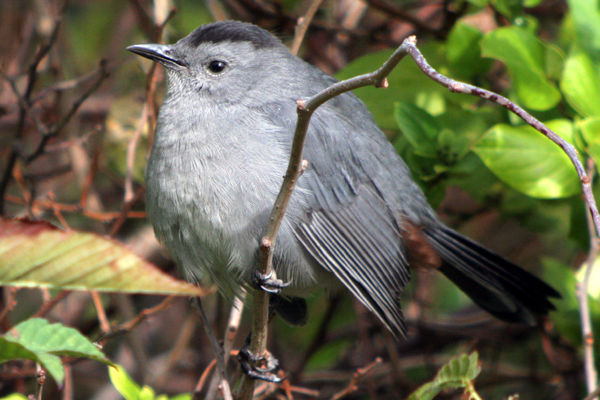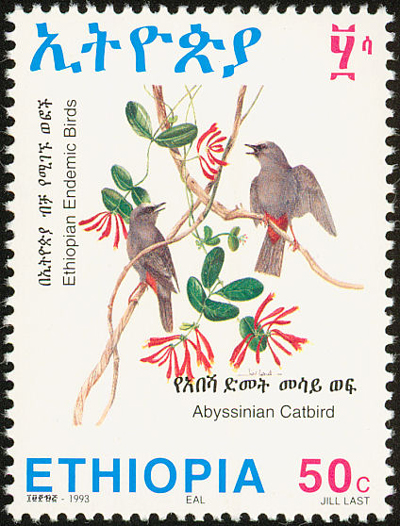We can start first with what catbirds are not. Catbirds are not the unfortunate result of unwise experiments with radioactivity. Catbirds are also not the result of unholy intercourse between avians and felines. They are not flying cats nor birds with whiskers. So what are catbirds?
Catbirds are a group of rather distantly related species all named for the fact that they make sounds that remind some of a cat meowing. Birds called catbirds include two species in the New World family, Mimidae, four from the bowerbird family, Ptilonorhynchidae, and one from the Old World babblers, Timaliidae.
The Gray Catbird Dumetella carolinensis is a common bird across most of North America, excepting the far west and northern Canada. It is the only species in the genus Dumetella and most likely the only catbird most birders will ever see; the Black Catbird Melanoptila glabrirostris, also of a monotypic genus, is found only in Mexico, Belize, and Guatemala, and is the only other species of catbird in the New World. Both catbird species in the Americas are part of the family Mimidae along with the mockingbirds, thrashers, and tremblers.
Gray Catbirds are one of the most common species that non-birders in their range are likely to have never seen nor identified. The catbird’s rather bland coloration – slate gray with a black cap and chestnut under the tail – doesn’t attract attention, and unlike their cousins, the mockingbirds, that often sing from exposed perches, catbirds prefer to sing their jumbled songs from cover. And it is the sounds that catbirds make that give them their name and makes it at all likely that their presence will be noted.
Gray Catbirds, to put it simply, have a call note that sounds like a cat with a scratchy and short meow. This sound emanating from a tangle of brush can easily fool those not in the know. The song of the Gray Catbird, however, is nothing like a cat meowing: like the mockingbird and thrasher the catbird often mimics other birds and sounds but it tends not to repeat itself. The rule of thumb is that if a phrase is repeated three times in a row it is a mockingbird, it it is repeated twice a thrasher is singing, and if each phrase of the song is sang just once one is dealing with a catbird.
Of the four species of catbird that are found in the family Ptilonorhynchidae three are in the genus Ailuroedus, and two of those, the Spotted Catbird Ailuroedus melanotis and the Green Catbird Ailuroedus crassirostris, are considered by some to be conspecific. They are both found in Australia, though the Spotted Catbird is also found in New Guinea. The third Ailuroedus catbird, Ailuroedus buccoides, or White-eared Catbird, is found on Papua New Guinea and in Indonesia.
The most interesting catbird in Ptilonorhynchidae, at least to this bird-blogger, is the Tooth-billed Catbird, Scenopooetes dentirostris, sometimes called the Stagemaker Bowerbird, the only bird in its genus and endemic to Australia. A description of the male’s courting behavior, which explains why I find it interesting, is below:
The male is polygamous and builds a display-court or “stage-type bower”, decorated with fresh green leaves laid with pale underside uppermost. The leaves are collected by the male by chewing through the leaf stalk and old leaves are removed from the display-court. The display-court consists of a cleared area containing at least one tree trunk used by the male for perching. Upon the approach of a female the male drops to the ground and displays. (source)
As for the final catbird, Abyssinian Catbird Parophasma galinieri, well, it is a babbler that comes from a monotypic genus and is endemic to Ethiopia. It has been described as “one of the finest, if not the finest singer of all the birds of Africa” on this site, which goes on to describe the Abyssinian Catbird‘s behavior and appearance much as one would describe a Gray Catbird:
Because the little-known catbird lives in dense parts of thickets, it is sometimes difficult to see. Distinguishing features are its general greyish color, dirty, white forehead and chestnut belly and undertail coverts.
So if you are from North or Central America, Ethiopia, New Guinea, or Australia make sure to check out that meow coming from the bushes: you might just be surprised to find a bird instead of a cat!
An aside: if you want to read a fascinating short article on how the Gray Catbird ended up in the genus Dumetella check out this article (the link takes you to a PDF).
(This post was first published in October 2009, but we don’t mind repeating ourselves when it comes to catbirds!)













Corey,
Nice article on a cool suite of mostly unrelated birds. I am fortunate enough to have seen most of them (missing Black, White-eared, and Abyssinian). I spent a long morning watching a Tooth-billed Catbird in Australia do its dance and prepare its bower. Quite a cool bird and a nice display. Got some decent photos too.
I enjoyed the read.
And a third name for Tooth-billed Catbird or Stagemaker Bowerbird is a cross between ’em: Tooth-billed Bowerbird, as per Morcombe. He separates the species from the other catbirds too by sticking three other species in between, unlike Handbook of the Birds of the World. Which leads me to ask, maybe a little off-topic: which taxonomy is the most accepted around the world?
Andy, I knew it as Tooth-billed Bowerbird as well in Australia. I hadn’t heard Stagemaker before, but I like it as it is rather descriptive of its courtship behavior. I think Clements (continued now by Cornell after his death) is the most popular one here in the United States. I want to say that Sibley & Monroe is used a lot in Europe/Asia but don’t have any data to back that up. I don’t know what taxonomy is used for the Handbook of the Birds of the World though. My copies are currently boxed up in storage so I can’t refer to them until I finish moving in a few months.
Thanks for the pointer to the Olson article, which I don’t remember having read before. The next ed of the AOU Check-list amended its Dumetella citation as recommended in the article–but no one appears to have figured out what the “SD” part of the pseudonym SDW means.
Nobody I know is especially happy with Clements, the latest edition of which was rather a mess; the ABA c’ee on standards is supposed this year to have determined whether to stick with it or not, but I haven’t heard the decision. Sibley and Monroe, as filtered through the new IOC English names, is the standard most use nowadays.
What a bizarre little story about Dumetella! Thanks for finding that. Also, I want to see some Pine Thickbills and Sibilous Brakehoppers.
Asking what taxonomy is most accepted is a little like asking which football team is the best 🙂
I think I knew what a catbird was before I became a birder.
Also, this is an informative post with great photos. I didn’t know about the catbirds other than Dumetella carolinensis.
@All: Thanks.
@Drew: Count me as jealous. Someday I’ll get a catbird besides a Gray…
@Rick and Nick: Glad to pass the link on. It’s amazing the digressions one can end up wanting to take when one starts researching.
@Rick Thanks for the heads-up about the IOC list. It looks like Wikipedia uses it and these days that’s becoming gospel. I have an option on my software (Wildlife Recorder) to switch to it from HBW and am wondering what will happen to my lists if I do. I don’t want to go backwards!!
@Nick My choice of football teams presently languishes near the foot of the division, so I’m less than confident about my choice of taxonomies.
Catbird doesn’t have whiskers eh? See my photo here. http://guitareth.blogspot.com/2017/06/2017-spring.html Perhaps not “real” whiskers but the resemblance is undeniable.
hello, lovely article, so enjoyable, thank you. I’m an oldie, Gould-Leaguer since primary school, now survive in outer-Perth region, near the wonderful, still quite wild Lake Joondalup, in Western Australia where perhaps I just saw a Western
Grey Catbird (Ailuroedus crassirostris) . I followed your link, where “not found” keeps coming up, so maybe said link needs a little of your TLC – (I took a screenshot but there’s no way to forward same to you, here). Peace, XS